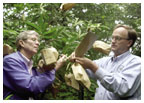|
Web Exclusives: Alumni Spotlight
June 6, 2004: Saving
the American chestnut A hundred years ago, American chestnut trees stood so densely in the Appalachian Mountains that their white blooms looked like snow blanketing the hills. In some areas, fallen nuts lay inches deep on the ground, providing a valuable food source for wildlife — and humans — from Maine to Florida. But all that changed when a devastating blight swept the Eastern seaboard in 1904, killing some 4 billion chestnut trees in the next several decades. Now only a small number of healthy, old chestnut trees remain; new saplings continue to spring up, but they live only a few years before the blight kills them. Two Princetonians are working to change that. Paul Sisco ’67 and Philip Pritchard ’61 are part of an ambitious effort to bring the trees back through a breeding program launched by the American Chestnut Foundation. “The forests were much healthier before the blight,” says Pritchard, the foundation’s development and special projects director. “And they could be again.” In 1989, the foundation began crossing American chestnut trees with blight-resistant Chinese chestnuts. Sisco, a geneticist with a B.A. in history from Princeton and a Ph.D. in plant breeding and genetics from Cornell, joined the foundation in 1998. Based in Asheville, North Carolina, Sisco coordinates the breeding efforts of chapter volunteers in six southern states. Volunteers receive pollen from blight-resistant hybrids grown at the foundation’s Meadowview Research Farm in Meadowview, Virginia. They then find and pollinate healthy American chestnut saplings in their respective states. Later, they plant seeds from these trees to produce resistant trees adapted to local conditions. Meanwhile, Meadowview Research Farm has produced several generations of resistant hybrids, each more American in its genetic makeup than the last. Trees in the newest generation are now about two years old and four feet tall. The seeds from these trees, which should be ready for planting in 2007 or 2008, will be returned to the woods. “All of this is still experimental. We are learning as we go,” says Sisco, who hopes to have enough seeds to share with the public by 2012. Last year the foundation received its first federal grant, $60,000 from the U.S. Forest Service, and the 2004 Department of the Interior appropriations bill has allotted the project $250,000. That’s good news for Pritchard, a biology major at Princeton who had worked in real estate and for the Nature Conservancy before rallying support for the foundation, which he joined in 2002. But while support and excitement are growing, the foundation’s
ultimate goal — a thriving population of American chestnuts
— won’t be accomplished for at least a hundred years,
says Sisco. “In this day and age when everyone wants instant
results, tree breeders have an unusual perspective on life and the
future,” he says. “They are working for the benefit
of their children and grandchildren.” By Christine Larson ’90 Christine Larson ’90 is a freelance writer in Sacramento, California.
|
||

